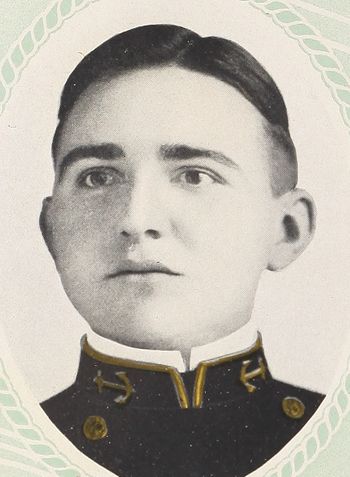JOHN T. MELVIN, LTJG, USNRF
John Melvin '11
Lucky Bag
From the 1911 Lucky Bag:
John Tillman Melvin
Selma, Alabama
"Jack" "Arturo" "Caruso"
ALL Selma, now that Jack is about to graduate, is swelling with pride in her famous representative—famous as much for his wit as for his avoirdupois. A noise like the outside of a circus sideshow, along with a clog-dance rendition of "All policemen have big feet" is a sure preliminary of Jack's approach. He enters—with the deep bow of the real Arturo—and with a few preliminary fraps, makes himself entirely at home. The survivor of a three-round contest with Sesh Boy in the steam room of the Gym. As a proof of his astonishing versatility, he sings in the Choir, holds down two chairs on one end of the Masqueraders Minstrel Show, and gains one number on Pierpont Mohle each year. He is a joke, but a good one, and for this as well as for many other qualities he has enjoyed an ever-increasing popularity with the Class.
"I ain't nothin' if I ain't light on my feet."
Choir (2, 1); Masqueraders (2, 1).
John Tillman Melvin is a native of Selma, Alabama, where he was born on October 16, 1887. He left school—Dallas Academy in Selma—at the age of thirteen, spending the succeeding six years as a bank clerk. At nineteen, he was appointed to the Academy.

John Tillman Melvin
Selma, Alabama
"Jack" "Arturo" "Caruso"
ALL Selma, now that Jack is about to graduate, is swelling with pride in her famous representative—famous as much for his wit as for his avoirdupois. A noise like the outside of a circus sideshow, along with a clog-dance rendition of "All policemen have big feet" is a sure preliminary of Jack's approach. He enters—with the deep bow of the real Arturo—and with a few preliminary fraps, makes himself entirely at home. The survivor of a three-round contest with Sesh Boy in the steam room of the Gym. As a proof of his astonishing versatility, he sings in the Choir, holds down two chairs on one end of the Masqueraders Minstrel Show, and gains one number on Pierpont Mohle each year. He is a joke, but a good one, and for this as well as for many other qualities he has enjoyed an ever-increasing popularity with the Class.
"I ain't nothin' if I ain't light on my feet."
Choir (2, 1); Masqueraders (2, 1).
John Tillman Melvin is a native of Selma, Alabama, where he was born on October 16, 1887. He left school—Dallas Academy in Selma—at the age of thirteen, spending the succeeding six years as a bank clerk. At nineteen, he was appointed to the Academy.
Loss
John was lost on November 5, 1917 when USS Alcedo (SP 166) was torpedoed and sunk off the coast of France while on convoy escort duty.
Other Information
From researcher Kathy Franz:
From age six John attended Dallas Academy in Selma and graduated in 1902. He next worked five years at the Selma National Bank where his father was President.
In March 1911 John’s brother E. Carlisle was appointed through the efforts of Congressman William B. Craig to be a member of the visiting board to the Naval Academy. As such, he was invited to the commencement week activities.
In 1914 John was on the USS South Carolina which was stationed at Puerta Plata, San Domingo. Previously, John was in command of a company of men sent ashore by Admiral Fletcher to seize the city of Vera Cruz.
In August 1915 John resigned to enter professional life. He was employed with the Lake Torpedo Boat company building submarines at Bridgeport, Connecticut. When the war broke out, he re-enlisted, but at first was not called to duty. At his insistence and the request of Commander William T. Conn, one of his instructors at the Naval Academy, he was finally assigned to duty.
In 1917 John was on the Scorpion before being on the Alcedo. John’s last letter to his parents was written just hours before his death. It included the following: “I should think that every able bodied young man would feel embarrassed when they claimed exemption – even when they are really needed at home. I am nobody’s hero, but goodness knows that I am glad to be among the first on the scene.”
Per The Selma Times-Journal of July 22, 1918, the city of Selma honored John with a memorial and an unveiling ceremony.
“The memorial is a beautiful boulder made of one piece Georgia marble, and weighing over ten thousand pounds. Its sculptor is William Grant, now of Georgia. He is a Scotchman, and a native of Edinburgh. The monument is beautifully erected upon the corner of the federal building lawn, and terraced around. The erection was made by J. W. Peters, to whom the contract was awarded.
“A platform was erected beside the monument on which were seated the speakers and the singers. The platform was beautifully decorated in the American colors, and the allied flags were strung over across the street, with a huge United States flag veiled over the monument. Chairman T. J. Rowell presided and introduced the speaker, Hon R. H. Mangum. Mr. Rowell read a telegram received from the commander of the ship of Lieut. Melvin, which bespoke the bravery of this gallant American.
“Mr. Mangum said: This occasion would be mournful indeed were it not for the bright lights of comfort and inspiration which will ever emanate from a contemplation of the life and character our hero, in whose hour we have erected this loving memorial. We have gathered with sorrowing hearts, empathy for his loved ones in their great loss permeates every bosom but at the same we are animated by pulsations of pride and strong emotions of revivified patriotism.”
Later in the newspaper article . . . Lieutenant Paul, a brother officer and shipmate writes: “His kean sense of humor and cheerful nature were a shining example for any man to follow, and it has carried us through many a trying situation. We are all of us better men for having known him.”
“Commander Conn . . . wrote these words to his bereaved parents: “I can truly say that his last days can well be describe by that wonderful expression: ‘He saved others; himself he could not save.’”
Toward the end of the speech, Mr. Mangum said: “Would he not recall to our minds the fact that he met his death near Belle Isle, off the coast of France, where John Paul Jones hoisted the Stars and Stripes for the first time over an American man of war?”
The speech also included words from Lieutenant Patterson, his shipmate and bosom friend: “John was ready to die. I knew him for ten years and a squarer, straighter, cleaner lived man never existed. I hope that when my time comes I shall be as ready to meet my pilot.”
“Lieutenant Paul, who relieved him as officer of the deck at 12 o’clock on the fateful night, has said: ‘He turned the deck over to me in his same always cheerful way.’ Lieutenant Parrott has said: ‘I shall think of him as stepping off cheerfully in that smiling, debonair manner he would use in doing a kindness for a friend.’”
John’s father was a Civil War veteran. His mother was Mary Mattie. His brothers were E. Carlisle Melvin, who became president of the bank, and James Graham Melvin who was a bank assistant. His sisters were: Louise (Mrs. Walter G. Duncan,) Claude (Mrs. Hugh Mallory,) Ellen (Mrs. W. H. McKee,) and Marion (Mrs. James W. Craig.)
From Wikipedia:
Born at Selma, Alabama, Melvin was appointed midshipman 6 July 1907 and commissioned ensign 7 July 1911. He was promoted to Lieutenant (j.g.) on March 22, 1915. Resigning his commission 20 August 1915, he was appointed lieutenant (jg.), 9 February 1917, upon his joining the Naval Reserve.
Attached to the patrol boat Alcedo, Lieutenant (jg.) Melvin lost his life 5 November 1917 when that vessel was sunk by a German submarine in the war zone. Alcedo was the first American war vessel to go down in World War I, and Lieutenant Melvin is officially recognized as the first American naval officer to die in the war.
He had reported to Alcedo on June 12, 1917.
His father was listed as next of kin. John has a memory marker in Alabama.
The "Register of Commissioned and Warrant Officers of the United States Navy and Marine Corps" was published annually from 1815 through at least the 1970s; it provided rank, command or station, and occasionally billet until the beginning of World War II when command/station was no longer included. Scanned copies were reviewed and data entered from the mid-1840s through 1922, when more-frequent Navy Directories were available.
The Navy Directory was a publication that provided information on the command, billet, and rank of every active and retired naval officer. Single editions have been found online from January 1915 and March 1918, and then from three to six editions per year from 1923 through 1940; the final edition is from April 1941.
The entries in both series of documents are sometimes cryptic and confusing. They are often inconsistent, even within an edition, with the name of commands; this is especially true for aviation squadrons in the 1920s and early 1930s.
Alumni listed at the same command may or may not have had significant interactions; they could have shared a stateroom or workspace, stood many hours of watch together… or, especially at the larger commands, they might not have known each other at all. The information provides the opportunity to draw connections that are otherwise invisible, though, and gives a fuller view of the professional experiences of these alumni in Memorial Hall.
January 1912
January 1913
January 1915
January 1916
Namesake
Both USS Melvin (DD 335) and USS Melvin (DD 680) were named for Melvin; the latter ship was sponsored by his grandniece.
Memorial
John's classmates erected a plaque in his honor in Memorial Hall.
Memorial Hall Error
John resigned his commission on August 20, 1915; when he returned to the service on February 9, 1917, it was as a member of the "USNRF" (US Naval Reserve Force). He is listed in Memorial Hall with his classmates as "USN," though the plaque dedicated by his classmates in Memorial Hall has USNRF.

The "category" links below lead to lists of related Honorees; use them to explore further the service and sacrifice of alumni in Memorial Hall.